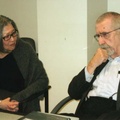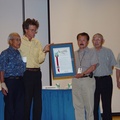Read Part 2 >>
The Stockade: Symbol of the Worthlessness of U.S. Citizenship
With the Center’s elected leaders imprisoned in the stockade, the stockade became the omnipresent reminder of the keepers’ arbitrary use of power at Tule Lake. It was an evocative reminder of the unjust post-Pearl Harbor roundups of Japanese American community leaders who were singled out and imprisoned, punished for their prominence and leadership.
In a 15-page letter written September 19, 1944 to U.S. Attorney General Francis Biddle,1 a group of 27 inmates imprisoned in the stockade, who were later moved to the Department of Justice prison in Santa Fe, NM, asked why they were imprisoned. None was charged with a crime, given a hearing, or sentenced.
“On what charge or for what reason, or on what evidence, are one hundred eighty-six of us being held in the stockade without any specified reason or with some reason utterly unknown to us, for a period of five to eight months since November, 1943?” the prisoners asked. They then described the response of Army Commander Austin: “Instead of giving an immediate reply, the commander [Austin] kept his eyes on the ceiling for a few minutes. Then he told us that so far there were no reason, no charge, and no evidence, but he would have strong evidences against us in the near future.”
The letter from these inmates raised issues of inadequate healthcare and medical facilities and equipment, quantity and quality of food supplies, housing deficiencies, racism of WRA staff, and lack of representation, and describes the disappointing result of their earlier attempts at democratic governance:
There was a common desire for a center-wide movement to improve the general living condition in the center. Supported by all the residents, the block representatives worked hard day and night with no material compensations. Their sincere efforts, however, resulted in vain because of the cold response on the part of the center officials. The administration was really indifferent and deaf to the popular wishes. Finally, we were arrested, interned, and sent to Santa Fe Detention Station on the basis of the one-sided evidences of the Tule Lake authority. It has been our sincere and earnest desire that our side be heard as well as the other.
You stated we must be interned on the grounds that we were liable to [disturb] the peace of the United States (Tule Lake Center) and that you had clear evidences to support your claim. We believe, however, that your evidences consist solely of the one-sided reports made by the officials of the Tule Lake Relocation Center. And such reports we consider untrustworthy because we have had no occasion to present our points of view.
To the American citizens imprisoned in the stockade, the worthlessness of their U.S. citizenship was evident when representatives of the Spanish Consulate visited Tule Lake, representing Japanese interests in the U.S. in the absence of diplomatic relations with Japan. The Spanish Vice-Consul, Captain Antonio Martin, visited Tule Lake on July 28 and 29, 1944 during a hunger strike in the stockade. They requested permission to interview individuals in the stockade, but were denied because, they were told, the individuals were American citizens and thus outside the jurisdiction of the Spanish Consul. At the end of his visit, Martin made a request that the persons being held in the stockade be released immediately. The Vice-Consul’s request was refused on the grounds that the men imprisoned in the stockade were American citizens.2 To the imprisoned Americans, the message was clear: unless they renounced their U.S. citizenship and became "enemy aliens" who were protected by the Geneva Conventions, they would have no rights and no protection.
WRA Collaborators and Spies
After the WRA imprisoned the Center’s elected leadership in the stockade, the WRA called for new elections to establish a group of candidates to replace the Daihyo Sha Kai leaders. On January 7, 1944 the Army and WRA recruited 40 people referred to as the “Responsible Men” to assist them. In a secret ballot controlled by the military, seven were elected. On January 15, the Army and the WRA gave this elected group, named the “Coordinating Committee,” immediate recognition. Almost simultaneously the Army announced the lifting of martial law, and returned management of Tule Lake, except for the stockade, over to WRA personnel.3
The seven Coordinating Committee appointees were drawn from the “loyal” group of 6,000 inmates who remained in Tule Lake after segregation, a population that included the entrepreneurial Cooperative Enterprises group. The new transfers who arrived at Tule Lake from the other WRA camps were a “have-not” segment of the Center. They arrived at Tule Lake with limited financial resources, and observing the “old Tuleans” having first pick of jobs and housing, in contrast to their own unemployment and lack of income, felt worry and resentment.4
The impoverished newcomers regarded the Coordinating Committee with suspicion, as administration stooges and co-op “inu.” In contrast to the administration-friendly Coordinating Committee, the now-imprisoned Daihyo Sha Kai members had argued that many things like fresh fruits and vegetables, fresh fish, and sundry items like soap should be provided free by the WRA instead of being sold at a profit by the co-op, which was operated and controlled primarily by the established pre-Segregation group.5 To the newcomers, Cooperative Enterprises was viewed as a way of making money off the inmates rather than helping to improve conditions.
With the growing tensions caused by unemployment as well as the emergence of a group seeking re-segregation to allow them to live among others who also desired to move to Japan after the war, the Coordinating Committee responded by hiring spies. With savage irony Michi Weglyn wrote, “Realizing that the seething discontent among the unemployed could momentarily erupt into violence, the Coordinating Committee had little difficulty persuading the WRA to open up job opportunities involving the appointment of 30 men with WRA remuneration for the purpose of performing intelligence work which is to be used only for the advantage and benefit of the colony.’”6
The WRA hired 30 spies, or confidential informers, euphemistically referred to as “fielders,” who infiltrated meetings, recorded incriminating opinions in boiler rooms, latrines, laundries, mess halls, and other places to eavesdrop on dissenters, wrote Weglyn. “Dossiers were maintained on anti-administration heretics, agitators, and those suspected of underground sympathies.”7 It did not take long for the Segregation Center to be permeated with corrosive suspicion, mistrust and intimidation over pro-administration spies and collaborators—a situation that recalled post-Pearl Harbor arrests of hundreds of innocent Issei leaders based on misrepresentations of “inu” in the government’s pay.
The Coordinating Committee’s term of office lasted less than three months. They resigned on April 10, 1944, believing that the WRA undermined their authority when, without consulting them, a WRA official gave permission to the re-segregation movement to circulate a petition8 signed by 6,500 persons requesting eventual repatriation or expatriation to Japan and separation from the “old Tuleans” who wanted to remain in the U.S.9 After the Coordinating Committee resignations, the Center had no inmate governance or liaison group that the WRA would recognize. The only representatives were the block managers, who were chosen, appointed, and paid by the WRA.10
In May, the WRA announced there would be elections for new representatives. This announcement was received with apathy in the inmate community. The FBI reported, “It now appears that the Japanese are content to let the situation remain as it is without any government of their own.” The view from within the Segregation Center, however, was that the colony’s elected leaders were imprisoned in the stockade and being detained without cause. “It should be noted,” stated the FBI, “that many of these men being detained in the stockade were members of the negotiating committee and have refused to resign from that committee. All attempts to elect another negotiating committee [have] failed.”11 The WRA’s effort to replace the democratically elected and still imprisoned Daihyo Sha Kai members with the Coordinating Committee ended in a stalemate.
Notes:
1. National Archives I, Washington, D.C. RG 210, Entry 480, Box 274, Tule Lake Relocation files 423-425.3 Declassification # NND802054. Letter written September 19, 1944.
2. FBI Report, August 2, 1945, page 192-93.
3. Supplemental Report, page 98-99. Also, Dorothy Swain Thomas and Richard Nishimoto, The Spoilage, page 212
4. Brian Masaru Hayashi, Democratizing the Enemy, pages 154-56. Many of those transferred to Tule Lake were described as economic rather than political refugees, with little cultural affinity or apparent loyalty to Japan. A significant number of the segregees from Topaz, Poston and Manzanar were young families who arrived in Tule Lake with few financial resources.
5. Supplemental Report, page 97, and Michi Weglyn, Years of Infamy, page 206.
6. Weglyn, page 207, citing Thomas and Nishimoto, page 205.
7. Weglyn, page 207, citing Thomas and Nishimoto, page 205. In the Spoilage, Thomas and Nishimoto report “on February 1, two fielders were assigned to work in Ward VII since problems had been reported in blocks 66, 69, and 70. Trouble was reported on February 3 from Ward VI, to which three fielders were dispatched the next day. They reported ‘general unrest’ in blocks 49 and 52. On February 5, B-9, a fielder (the fielders were known by numbers) reported that troublemakers in blocks 27, 53, 54, and 67 were ‘busily plotting to overthrow the committee.’ The next day three fielders were instructed to work in wards II and VII.”
8. National Archives I, Washington, D.C. RG 210, Entry 48, box 274, files 23-25.
Letter from Harry L. Black, Assistant Project Director to Sanae Akashi, March 29, 1944 gives consent to the Regregationists to make a survey that led to the resignations of the Coordinating Committee. “There is no objection on the part of the administration to the proposal that you and your committee make a survey to determine the wishes of residents with respect to further segregation within the Center.
The information to be derived from the survey would be as follows:
- Persons and families who have applied for repatriation or expatriation, who wish to return to Japan at the earliest opportunity, and who wish to live in a designated section of the Center among others of like inclination.
- Persons and families who have not applied for repatriation or expatriation, who have reached no conclusion with respect to an early return to Japan, and who wish to live in a section of the Center not specifically designated for persons and families of the first group above…
- The survey may be made without commitment on the part of the administration, either stated or implied, that the results of the survey will be made the basis of administrative action beyond that which is already established for housing adjustments through the Housing Office.”
9. Thomas and Nishimoto, page 216
10. FBI Report, August 2, 1945, page 187. Supplemental Report, page 105
11. FBI Report, August 2, 1945, page 187.
* This article was originally published in the Journal of the Shaw Historical Library, Vol. 19, 2005, Klamath Falls, OR.
* * *
* Barbara Takei will be a presenter for “The Tule Lake Segregation Center: Its History and Significance” session at JANM’s National Conference, Speaking Up! Democracy, Justice, Dignity on July 4-7, 2013 in Seattle, Washington. For more information about the conference, including how to register, visit janm.org/conference2013.
© 2005 Barbara Takei








